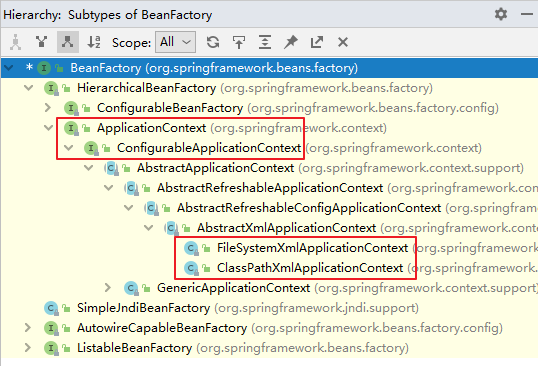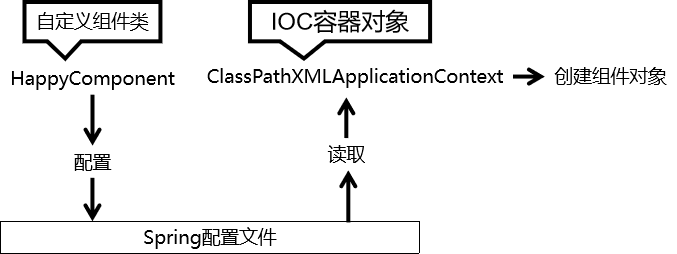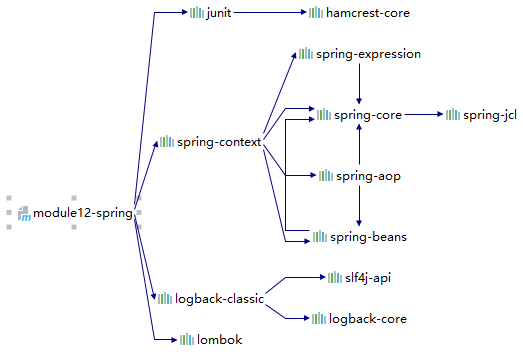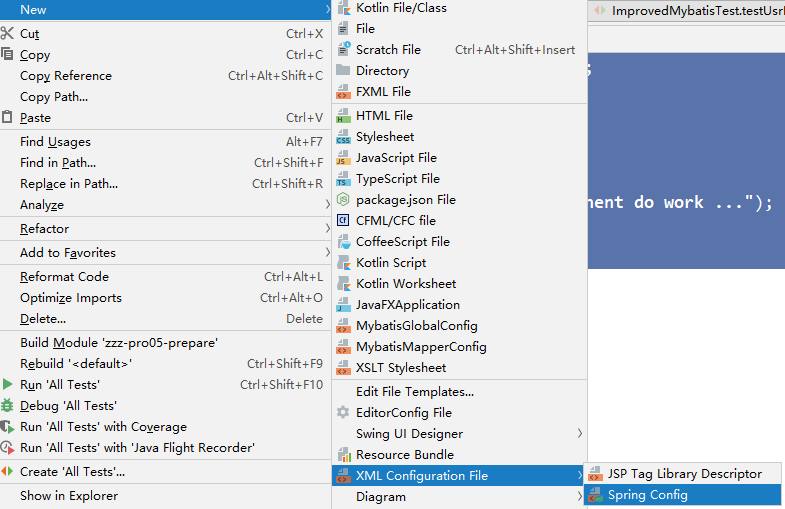IOC容器在Spring中的实现(基于XML管理Bean)
基于XML管理Bean
Spring 的 IOC 容器就是 IOC 思想的一个落地的产品实现。
IOC 容器中管理的组件也叫做 bean。在创建 bean 之前,首先需要创建 IOC 容器。
①BeanFactory接口:
这是 IOC 容器的基本实现,是 Spring 内部使用的接口。
面向 Spring 本身,不提供给开发人员使用。
②ApplicationContext接口:
BeanFactory 的子接口,提供了更多高级特性。面向 Spring 的使用者,
几乎所有场合都使用 ApplicationContext 而不是底层的 BeanFactory。
以后在 Spring 环境下看到一个类或接口的名称中包含 ApplicationContext,
那基本就可以断定,这个类或接口与 IOC 容器有关。 对我们开发人员来说,
ApplicationContext就是代表整个IOC容器技术体系的顶级接口。
③ApplicationContext的主要实现类:

FileSystemXmlApplicationContext:
以磁盘文件中某个xml通过一个磁盘路径获取当前ioc容器,
所以这个不用: 因为java工程要打jar包,需要在其他电脑上执行,
其他电脑上相对应磁盘路径中也要有当前文件但是不一定有,
所以现在用ClassPathXmlApplicationContext。
| 类型名 | 简介 |
|---|---|
| ClassPathXmlApplicationContext | 通过读取类路径下的 XML 格式的配置文件创建 IOC 容器对象 |
| FileSystemXmlApplicationContext | 通过文件系统路径读取 XML 格式的配置文件创建 IOC 容器对象 |
| ConfigurableApplicationContext | ApplicationContext 的子接口,包含一些扩展方法 refresh() 和 close() ,让 ApplicationContext 具有启动、关闭和刷新上下文的能力。 |
| WebApplicationContext | 专门为 Web 应用准备,基于 Web 环境创建 IOC 容器对象,并将对象引入存入 ServletContext 域中。 |
实验一:创建bean
1 . 目标
由 Spring 的 IOC 容器创建类的对象。

引入依赖:spring-webmvc(或者下面的)
<dependencies>
<!-- 基于Maven依赖传递性,导入spring-context依赖即可导入当前所需所有jar包 -->
<!--
spring-context:上下文
ApplicationContext:应用上下文
-->
<dependency>
<groupId>org.springframework</groupId>
<artifactId>spring-context</artifactId>
<version>5.3.1</version>
</dependency>
<!-- junit测试 -->
<dependency>
<groupId>junit</groupId>
<artifactId>junit</artifactId>
<version>4.12</version>
<scope>test</scope>
</dependency>
<!-- 日志 -->
<dependency>
<groupId>ch.qos.logback</groupId>
<artifactId>logback-classic</artifactId>
<version>1.2.3</version>
</dependency>
<!-- Lombok -->
<dependency>
<groupId>org.projectlombok</groupId>
<artifactId>lombok</artifactId>
<version>1.18.12</version>
<scope>provided</scope>
</dependency>
</dependencies>

2. 创建组件类
这里我们创建的这个类,就是我们希望由IOC容器创建对象的类:
package com.atguigu.spring.pojo;
public class HelloWorld {
public void sayHello(){
System.out.println("hello,spring!");
}
}
3. 创建 Spring 配置文件

-
bean标签:通过配置bean标签告诉IOC容器需要创建对象的组件是什么
-
id属性:bean的唯一标识
-
class属性:组件类的全类名
4. 测试类
package com.atguigu.spring.test;
import com.atguigu.spring.pojo.HelloWorld;
import org.junit.Test;
import org.springframework.context.ApplicationContext;
import org.springframework.context.support.ClassPathXmlApplicationContext;
public class HelloworldTest {


 浙公网安备 33010602011771号
浙公网安备 33010602011771号